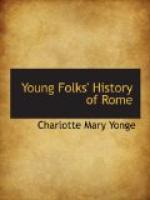It was just then that his son Titus, having taken all the strongholds in Galilee, though they were desperately defended by the Jews, had advanced to besiege Jerusalem. All the Christians had heeded the warning that our blessed Lord had left them, and were safe at a city in the hills called Pella; but the Jews who were left within were fiercely quarrelling among themselves, and fought with one another as savagely as they fought with the enemy. Titus threw trenches round and blockaded the city; and the famine within grew to be most horrible. Some died in their houses, but the fierce lawless zealots rushed up and down the streets, breaking into the houses where they thought food was to be found. When they smelt roasting in one grand dwelling belonging to a lady, they rushed in and asked for the meat, but even they turned away in horror when she uncovered the remains of her own little child, whom she had been eating. At last the Roman engines broke down the walls of the lower city, and with desperate struggling the Romans entered, and found every house full of dead women and children. Still they had the Temple to take, and the Jews had gathered there, fancying that, at the worst, the Messiah would appear and save them. Alas! they had rejected Him long ago, and this was the time of judgment. The Romans fought their way in, up the marble steps, slippery with blood and choked with dead bodies; and fire raged round them. Titus would have saved the Holy Place as a wonder of the world, but a soldier threw a torch through a golden latticed window, and the flame spread rapidly. Titus had just time to look round on all the rich gilding and marbles before it sank into ruins. He took a terrible vengeance on the Jews. Great numbers were crucified, and the rest were either taken to the amphitheatres all over the empire to fight with wild beasts, or were sold as slaves, in such numbers that, cheap as they were, no one would buy them. And yet this wonderful nation has lived on in its dispersion ever since. The city was utterly overthrown and sown with salt, and such treasures as could be saved from the fire were carried in the triumph of Titus—namely, the shew-bread table, the seven-branched candlestick, and the silver trumpets—and laid up as usual among the spoils dedicated to Jupiter. Their figures are to be seen sculptured on the triumphal arch built in honor of Titus, which still stands at Rome.
[Illustration: ARCH OF TITUS.]
These Flavian Caesars were great builders. Much had to be restored at Rome after the two great fires, and they built a new Capitol and new Forum, besides pulling down Nero’s Golden House, and setting up on part of the site the magnificent baths known as the Baths of Titus. Going to the bath, to be steamed, rubbed, anointed, and perfumed by the slaves, was the great amusement of an idle Roman’s day, for in the waiting-rooms he met all his friends and heard the news; and these rooms were splendid halls,




